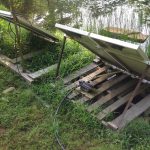It was the Fourth of July, 1976, the day of the bicentennial of the United States. I was working that summer as a truck driver, pulling a forty-foot flatbed trailer around the Midwest trip-leasing loads from place to place, staying out six weeks at a time.
Since I was laid over near Minneapolis for the holiday weekend, I stopped to visit my ex-girlfriend Monica and her husband John Bowman, who lived in the country near South Haven, Minnesota. John was a real wild man; he had hitchhiked and hoboed all around the country, and had a genuine type A personality. I had taken a few short rides on freight trains and really enjoyed John’s stories of riding trains across the country. He told me of a great ride he often took, just a short hop from South Haven to about sixty miles west, where the trains always stopped. From there he would hitchhike back home on the highway that paralleled the tracks.
That afternoon Monica came home from work and mentioned that there was a train on the siding in South Haven, and that we might want to take that short ride and still get home in time to get to St. Cloud for the fireworks show that night. Since it doesn’t get dark there in July until almost 10:00 John and I decided to give it a shot.
When we got to the siding the train was just starting to pull out, and we had to run and jump into an empty box car with the train already moving. Soon we were clipping along at sixty miles an hour, enjoying the warm summer afternoon, waving at kids in cars at crossings and having a great time. John explained that the train would slow down to about twenty miles an hour at the Great Northern Crossing at Belgrade, then after about thirty more miles at top speed would stop at Glenwood, where we would disembark and hitch a ride home.
Southern Minnesota is beautiful in mid summer. As we sped along through the warm July afternoon, I noticed that at many county road crossings rickety-looking wooden bridges had been built so the road actually passed over the double railroad line, something that I had not seen before, and that would have an impact on me later that evening.
As John had predicted, the train slowed down at the Great Northern Crossing, then increased in speed again. Here it appeared that Union Pacific was replacing ties, because we saw hundreds, maybe thousands of used ties laying along the railroad track. These, too, would come into play later in our ill-fated trip.
An hour or so later the train slowed again, and came to a stop just outside of Glenwood, Minnesota. It was maybe two hours to sunset, so we hopped out of our boxcar, walked over to the highway, and stuck out our thumbs. We figure we had plenty of time to catch a ride back to South Haven and still make it to St. Cloud for the bicentennial fireworks. What we hadn’t counted on was that late in the afternoon on the Fourth of July there was very little traffic, and the few cars that did pass by we’re filled with tourist families that were not very likely to pick up a couple of scroungy hitchhikers.
After standing with our thumbs out for 45 minutes or so we could see that hitching a ride on the highway wasn’t going to work, so we began to eye the train that was idling on the eastbound track. I had the idea that maybe if we asked nicely the train crew might give us a ride and drop us off at South Haven. As we walked up to the lead locomotive, the engineer, who had observed us standing on the shoulder of the highway with our thumbsout, came out on the catwalk and said “Boys, you’re welcome to ride my train but I only have three empty cars and they are flatcars, the seventh, eighth, and ninth cars on the train”. We asked him about stopping at South Haven but he said that was out of the question, however we might be able to jump off when the train slowed for the Great Northern crossing. That sounded good to us because it was close enough to South Haven that if we could find a phone we might get Monica to come pick us up.
We had only just climbed up onto the first flatcar when the train began to roll. Before long we were clipping along through the gathering dusk. At that latitude, even in July, when the sun goes down it really begins to cool off, and we were wearing T-shirts, which meant we weren’t having quite as much fun as we had when we started out that afternoon. About the time it was getting pretty dark the train began to slow for the Great Northern crossing. I jumped over to the grain car ahead of us and got down on the ladder on the side of the car, while John got on the ladder of the flatcar. The train slowed to maybe twenty miles an hour, and as we peered into the darkness we remembered that earlier that day we had passed miles of railroad ties laid in the weeds along the track. To get off of the train at that speed would mean hitting the ground at a dead run, and running into a bunch of hidden ties would probably mean a broken leg or worse. As we hung there trying to work up the nerve to jump, the train started to pick up speed and we knew there was no getting off now. This meant a frigid three-hour ride into Minneapolis.
The grain car in front of us had a little cubbyhole in the back that was out of the wind, but years before John had fallen between two hay wagons and had a personal rule that he would never jump from one moving car to another. I could see that we were in for a very uncomfortable ride, so the idea came to me that if I could make my way up to the lead locomotive I might be able to persuade the engineer to stop, or at least slow down at South Haven so we could get off the train.
I jumped back across to the grain car and climbed up the ladder to the roof. Crouching low I made my way forty feet to the front of the car, walking on the removable fiberglass panels that cover the three-foot wide slot that runs the length of a grain rail car. At the front of the car I surveyed the distance to the next car, which was also a grain car. It looked to be about a six or seven-foot gap. I moved back down the car a ways, then ran as fast as I could and leapt to the next car, where I plastered myself to the roof. Success! Since I hadn’t fallen between the cars and been crushed under the wheels, I started feeling pretty hopeful that I might actually pull this crazy caper off. I got up and ran the length of the car and made the leap to the next car without even slowing down. Peering ahead through the darkness I could see four or five more cars, then the three big diesel locomotives pulling the train. I could hardly imagine the reception I would get when I strolled in the door of the lead locomotive, but I decided to get moving. Running as fast as I could on top of the swaying train, I jumped the gap on the next three cars without slowing down. Now there was only one more car between me and the locomotives.
What I saw now is that the last obstacle between me and the engines was a tank car with a rounded top, and no catwalk on top. I looked down on each side and saw that there was no catwalk along the sides of the car, either. It only took a moment for me to realize that this whole dangerous adventure had been for nothing. I immediately turned around and started making my way back down the train. After just a few steps I remembered that earlier that day I had seen those rickety-looking bridges where county roads crossed the tracks. Now that I had my back turned to the front of the train I was afraid that one of those bridges would come along unseen and put a sudden end to this story. So at the front of each car I would peer ahead at the sweeping headlight of the train, make sure no bridge was looming up, then run like crazy and leap to the next car. There I would look ahead again and make another run. All this was done on a train traveling at sixty miles an hour in near total darkness.
Eventually I made it back to John on the flatcar. We sat hugging each other for warmth and rode that train into the Minneapolis train yards around midnight, then made our way through a bad part of town until we found a pay phone. Monica was so mad about missing the fireworks that she refused to come pick us up, so we spent the night in a sleazy motel in the ghetto. The next morning we hitchhiked back to South Haven. Unbelievable as this story seems, it really is true. Looking back now after nearly forty years I realize what a dangerous stunt it was, and how lucky I am to have done it without getting myself killed. Now, when watching a movie, I see stunt men running along on the tops of trains, I can say “I did that!”.



